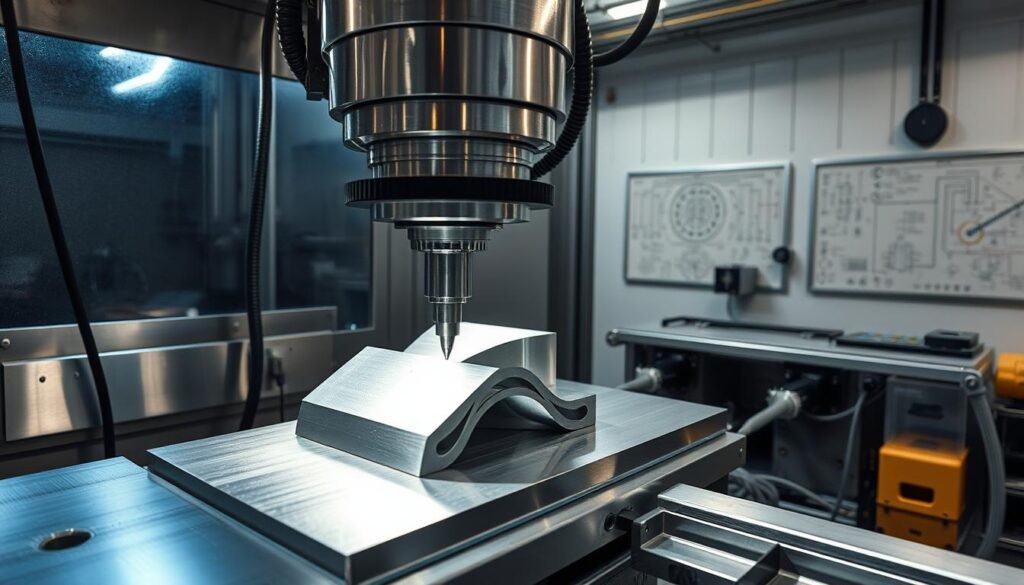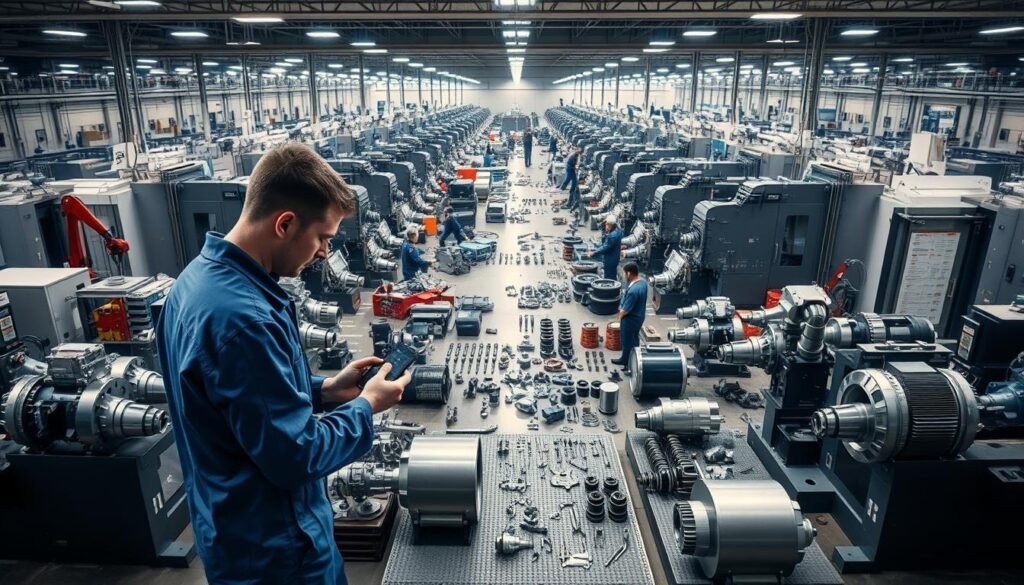Have you ever wondered how intricate parts are made so precisely and consistently? The secret is the CNC machining process. CNC stands for Computer Numerical Control machining. It’s a high-tech way of making things that changes how we manufacture.
This process uses special software to control machines and tools. It lets us make parts with great accuracy and efficiency. CNC machining brings a lot of advantages. It reduces mistakes, ensures consistency, speeds up production, and can make complex items. It works with many materials, like metals, plastics, and composites.
Now, let’s explore the amazing world of CNC machining more. It’s a key part of precision manufacturing in our world today.
Key Takeaways
- CNC machining leverages computer-controlled machines for precision.
- It significantly reduces human error and enhances consistency.
- The technology allows for rapid production and cost efficiency.
- It supports a wide range of materials, from metals to plastics.
- CNC machining enables the creation of intricate parts and designs.
Introduction to CNC Machining
CNC technology brought a huge change, making machines run by computers instead of by hand. This change made making things more precise, fast, and flexible.
What is CNC?
CNC means Computer Numerical Control. It’s where computers control how machines move and work. This switch to computers helps make very detailed items quickly and accurately. By using special design and manufacturing software, these machines can do complex jobs all on their own.
The History of CNC Machining
The start of CNC goes back to the 1940s. John Parsons and MIT researchers worked on a project for the U.S. Air Force. They wanted to make milling machines work automatically. This was the beginning of CNC.
Now, modern CNC uses smart computers and software. They can read blueprints and do precise work. This jump to advanced CNC has made making things better and more consistent, reducing mistakes.
How CNC Machining Works
CNC machining turns raw materials into precise parts and components. It’s a detailed process that ensures products meet exact needs. Each step is important for quality results.
Stages of CNC Machining
CAD modeling is where it all starts. Designers create a 2D or 3D plan of the part using software. This blueprint includes all dimensions and shapes.
Next, the CAD file becomes G-code, CNC’s language. CAM software then defines the tool paths. This guides the CNC machine in making the part.

Role of CAD and CAM Software
CAD and CAM software are key to CNC’s success. CAD lets engineers design in complex details. CAM then translates these designs into machine-ready instructions.
This partnership ensures accurate and repeatable part production. CAM software also selects the best tools and paths for efficiency.
Before the actual making, the CNC machine gets ready. This setup involves adjusting machine settings and securing the material. Then, the machine precisely follows the instructions to create the final product.
Different Types of CNC Machines
It’s key to know the different types of CNC machines to pick the right one for your work. Each kind is built to do specific jobs, showing how versatile and flexible CNC tech is.
CNC Mills
CNC mills are great for cutting, carving, and drilling into metals. They’re really precise and can make complex shapes with tight measurements. These machines are a top choice for making detailed parts in fields like aerospace, cars, and medicine.
CNC Lathes
CNC lathes make objects that are the same all around. They spin the material while a fixed tool shapes it into cylinders. This machine is super for making parts like shafts and bushings, used in many kinds of work.
CNC Routers
CNC routers are good with softer materials like wood, plastics, and foam. They’re mainly used for cutting, carving, and engraving. This makes them ideal for making furniture, signs, and models for buildings, thanks to their adaptability and power.
3D Printers
3D printers are a unique kind of CNC machine. They build parts from digital files, adding layers one at a time. This way of making things has changed how prototypes and special parts are created, especially for custom or limited runs.
Applications and Industries Using CNC Machining
CNC machining plays a big role in many industries. Its ability to work precisely, automatically, and with complex designs makes it stand out. In this piece, we explore its importance in making things for space, cars, and healthcare. We also look at its role in making unique, customized items.
Aerospace
Building things for space needs components that last under tough conditions. CNC machining is perfect for making engine parts, wheels for landing, and big parts of the structure. It works well with strong materials like titanium and Inconel, which is key for aerospace.
Automotive
The automotive industry uses CNC machining a lot. It’s used for designs and for making important pieces. This includes everything from the heart of the car to parts that make it move. As electric cars become more common, precise work is needed for battery cases and their parts.
Medical
In medical device production, there’s a growing need for specific tools and parts for surgery. CNC machining helps make detailed and very accurate devices that meet health standards. It’s impressive how it can make tailored implants for each patient, moving medical care forward.

Custom Manufacturing
Custom manufacturing gains a lot from CNC machining’s ability to adapt and change. It’s great for creating one-of-a-kind prototypes or large custom orders. This precision and flexibility meet the needs of many clients in different fields.
| Industry | Common CNC Applications | Benefits |
|---|---|---|
| Aerospace Manufacturing | Engine parts, structural components, landing gear | Precision, material versatility |
| Automotive Industry | Engine blocks, transmission parts, battery casings | Quality, durability, consistency |
| Medical Device Production | Implants, surgical instruments | Customization, high standards |
| Custom Manufacturing | Prototypes, bespoke parts | Flexibility, adaptability |
what is cnc machining process
The CNC machining process is a wonder in modern manufacturing. It uses computers to turn designs into exact parts, and shapes materials with incredible detail. This means it can make things manual work can’t.
CNC machining brings unmatched precision to manufacturing. It reduces mistakes by using automated tools. These tools make sure every piece is made the same way, every time.
This process also makes making things faster and cheaper. It uses automated systems that save time and resources. This keeps costs down and keeps things moving smoothly.
CNC machining has changed many industries by being both reliable and efficient. It’s important for making everything from planes to medical tools. It sets high standards and keeps pushing boundaries in making things.
Conclusion
The journey through this article shows us how CNC machining has changed modern manufacturing. The future of CNC machining looks promising with new technology progress. These advancements bring in smart software, better automation, and amazing precision, making CNC a key player in many industries.
We’re moving towards an exciting future where artificial intelligence and the Internet of Things are part of CNC processes. These additions aim to boost efficiency, predict maintenance needs, and allow for live monitoring. This increases work speed and lowers the chance of sudden stops. The advancements in CNC technology are opening doors to faster and more customizable production.
Many industries depend on CNC machining, from aerospace to custom manufacturing. It is vital for creating complicated and precise parts. As technology evolves, CNC will keep breaking new ground. In short, the future of CNC machining plays a huge role in making progressive and high-tech manufacturing real.
FAQ
What is CNC machining?
CNC machining is a way to make precise parts and components using computers to control machines. It automates the cutting of materials, gives great surface quality, and cuts down on mistakes made by humans.
What materials can be used in CNC machining?
Many materials, like metals (aluminum, titanium), plastics (nylon, polycarbonate), and composites, work well in CNC machining. This makes it flexible for lots of projects in many fields.
How does CNC machining differ from traditional manual machining?
CNC machining uses computers to control the machines, making it automated. This cuts down on errors, makes products more consistent, and speeds up making complex, precise parts.
Who invented CNC machining?
John Parsons and MIT started CNC machining in the late 1940s for a U.S. Air Force project. Since then, the technology has grown a lot, with today’s machines able to follow complex software commands easily.
What are the stages involved in CNC machining?
First, a CAD model is made in 2D or 3D. Then, it’s turned into a file the CNC machine can read, like G-code. CAM software plans out the machine’s actions. Finally, the machine is set up and starts working on the raw material.
What role do CAD and CAM software play in CNC machining?
CAD software helps design the parts, while CAM software turns those designs into instructions for the CNC machine. This guides the machine on how to make the part.
What are the different types of CNC machines?
There’s a variety: CNC Mills for metals, CNC Lathes for symmetrical parts, Routers for wood and plastic, and 3D Printers for layer-by-layer builds. Each type is best for certain jobs.
In what industries is CNC machining commonly used?
CNC machining is key in areas needing precision, like aerospace, automotive, and medical. It’s also used for custom projects in many other industries.
What makes CNC machining indispensable in the aerospace industry?
Aerospace parts must handle tough conditions. CNC machining’s precision and strength make sure these parts are high-quality and dependable.
How does the automotive industry benefit from CNC machining?
The automotive industry uses CNC for prototypes and production. This ensures parts meet strict standards for quality and durability, helping cars to be reliable.
Why is CNC machining important in the medical field?
CNC machining is crucial for making detailed, custom medical devices like implants and tools. Its accuracy and reliability are vital for these sensitive applications.
How is CNC machining evolving with technological advancements?
CNC is getting more advanced with smarter software and more automation. Adding artificial intelligence and connecting to the Internet of Things are making CNC even more important in modern making.




